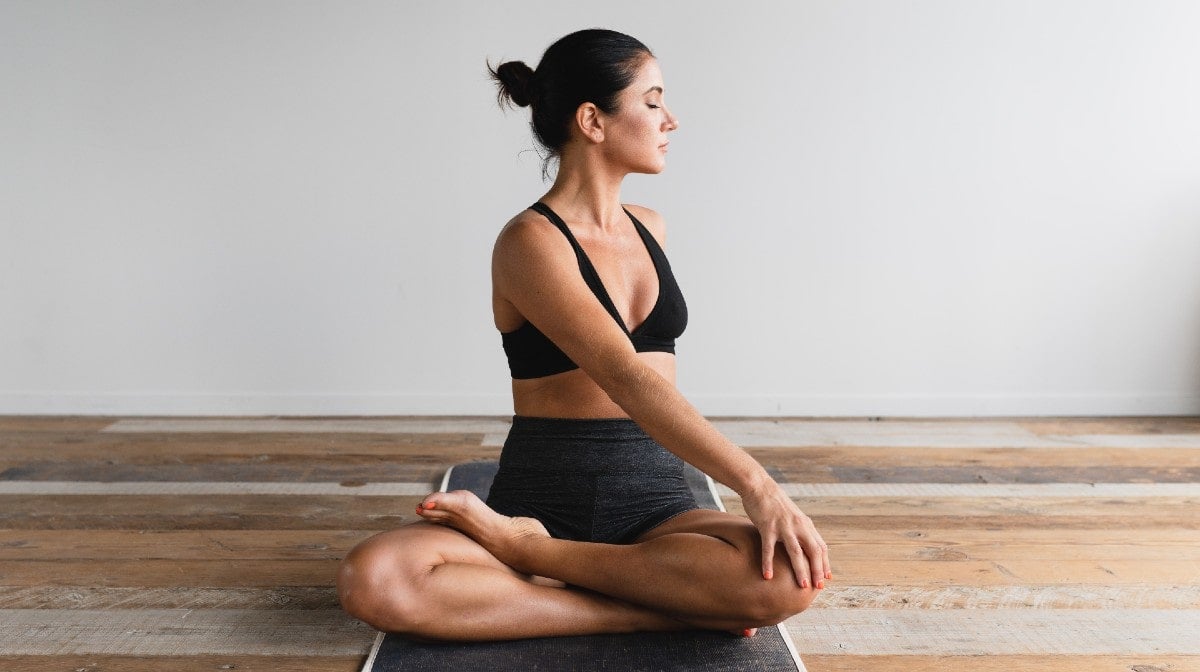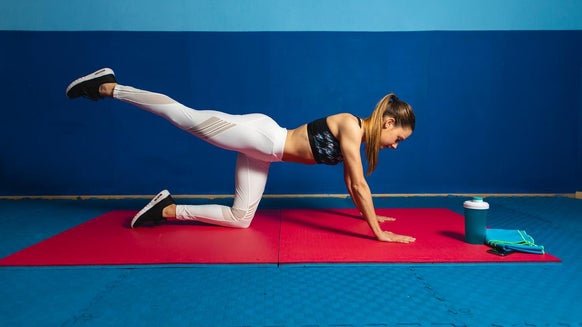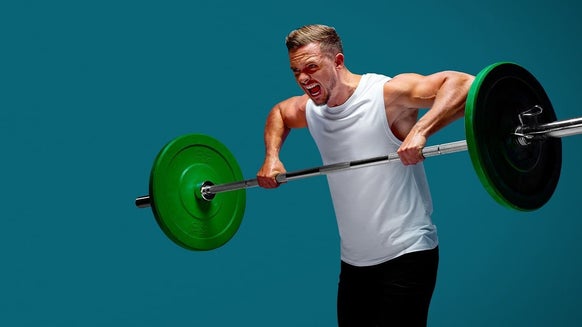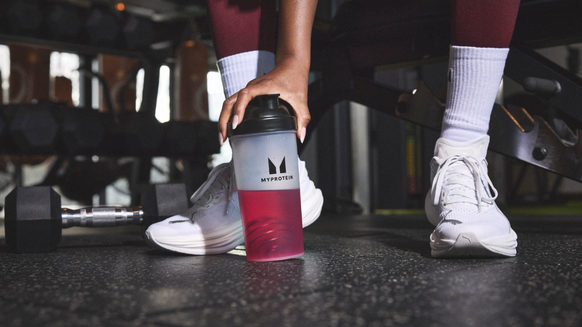
Maintaining good mobility is vital if you want to remain injury-free, as limitations to your available range of movement caused by tight muscle groups can result in compensations elsewhere.
When using resistance training, we know that altering the toe-angle in exercises like the leg extension or hamstring curl (along with other exercises) can result in preferential activation of individual muscles in a group.
While it is unlikely to result in a massive difference, the same may also be true of stretching muscle groups – so experiment with turning your foot when stretching to result in some preferential tension/stretching on specific areas.
1. Lying Hamstring Stretch
- Lying supine (with your back flat on the floor) with both legs straight, elevate one leg until you can hold it.
- Keep the other leg flat on the floor and use your arms to facilitate a greater stretch in the elevated leg.
- Only go as far as you can feel a stretch whilst keeping the leg straight.
- Hold the position for around 10 seconds before repeating on the opposite leg.
2. Sit and Reach
- Sit on the floor with your legs laid straight in front of you, with the back of your knee pressed to the floor.
- Bending only at the hips (allowing the lower back to also round), lean forwards towards your toes.
- Reach for your toes and hold the position where you begin to feel a stretch in your hamstrings (do not try to force yourself beyond your limits as this may result in injury!).
- Hold for around 10 seconds before relaxing.
- Perform multiple rounds, similar to a sets/reps/rest plan (i.e. 3x10secs, 15secs rest).
3. Hurdler Stretch
- Start sitting on the floor with your legs laid in front of you with the back of your knees against the floor.
- Shift your right foot so that the sole of the foot is against the side of your left knee/inner thigh (resembling a ‘p’ or ‘b’ shape).
- Keeping your left leg straight, lean forward with both hands, placing your hands next to/on your outstretched leg by your foot.
- Hold this position for around 10 seconds before repeating on the opposite leg.
4. Single Leg Elevated Hamstring Stretch
- While standing, elevate one foot onto a stable surface with a straight leg (try some stairs, as it’s easier to choose an appropriate height).
- Similar to the hurdler stretch, lean forwards towards the foot of the outstretched leg.
- Hold the position where you feel a stretch for around 10 seconds before releasing and repeating on the opposite leg.
5. Standing Bilateral Hamstring Stretch
- Start standing, and cross one foot to the other side of the opposite foot (so the outside of each foot is next to each other).
- Slowly lower your torso, bending only at the hips while keeping your knees straight.
- Use support such as a railing or work surface if you struggle to maintain your balance.
- Hold the position where you feel a stretch for around 10 seconds before alternating legs.
6. Standing Unilateral Hamstring Stretch
- Stand up straight with both legs straight.
- Step one foot forward, balancing on the heel, then lean forward, sliding your hands down that leg until you feel the stretch – allow the knee of the supporting leg to bend slightly.
- Hold the position where you feel a stretch for around 10 seconds before repeating on the opposite leg.
7. Nordic Hamstring Curl
Muscles are made up of base components known as sarcomeres, which together form fascicles, which ultimately form the muscle itself. While it is recognised that longer fascicles (which can result from stretching) play an important role in injury reduction, there is a wide base of research suggesting that this is nearly redundant if the muscles are not also strong. The Nordic hamstring curl offers eccentric overload to the hamstrings, ensuring that sarcomeres are added in parallel and in series (adjacent to each other, and length-ways) – resulting in longer and stronger muscle fibres.
- Start in a kneeling position, with your hips extended (so you’re only bent at the knee).
- Find a suitable anchor for your feet/ankles – ask a friend/partner to use their body weight and hold you down, or find a secure and stable item/surface that will do the job (make sure your ankles are protected so you don’t get injured).
- Contracting your hamstrings against the anchor (as if you are trying to flex your knees), slowly lower your body to the floor, whilst bending minimally at the hip.
- Use your arms to help press yourself back to the start position (it’s all about the eccentric phase in this exercise!).
- Perform 3-5 sets of 3-5 reps, around 2-3 times per week for optimal adaptations.
8. Proprioceptive Neuromuscular Facilitation (PNF)
PNF is an advanced technique for improving mobility and requires a partner to assist you. There are 3 different types of PNF; 1) Hold-Relax, 2) Contract-Relax, 3) Hold-Relax with agonist contraction.
Hold-Relax:
- Using the lying hamstring stretch (1), have the partner help you hold a passive stretch for 10 seconds.
- The partner then applies force (facilitating further hip flexion), and the athlete must ‘hold’ the position, isometrically contracting their hamstrings so that no movement occurs.
- This is held for 6 seconds, prior to a further passive stretch being held for 30 seconds (to a greater degree than the initial passive stretch).
Contract-Relax:
- This method begins with the same initial passive stretch, held at the point where a stretch is felt for 10 seconds.
- The athlete then concentrically contracts their hamstrings against the resistance applied by their partner, until the leg is straight with the hip extended.
- A further passive stretch is applied for 30 seconds, again greater than the initial passive stretch.
Hold-Relax with agonist contraction:
- A passive stretch is applied for 10 seconds, then the partner applies flexion force again.
- The athlete then contracts the hamstrings in addition to the passive stretch being applied by their partner.
- Finally, a deeper passive stretch should be applied by the partner.
Why are hamstring stretches important? What are the benefits?
Many individuals experience tight hamstrings, but oftentimes it is ignored as it may not have presented any significant issues yet. The key is to approach it from a ‘prehab’ perspective, using it as a tool to protect against injury, thus preventing the need for any rehab.
Understanding their value when implemented into your training will likely result in greater adherence and success in your future training.
They increase flexibility and ROM at the hip
Good flexibility is an important component of fitness, contributing to all sporting movements and more so to activities of daily living. Increasing your mobility could be the key to ensuring longevity in your exercise plan, meaning you can train during later life with fewer obstacles.
They reduce the risk of injury
When a greater range of movement is available at a joint, muscles are less susceptible to strains as the risk that they will be over-stretched is reduced. Of course, strains can still occur when too much load is introduced, so muscles should undergo resistance training along side stretching for the greatest benefits. Tight hamstrings can also contribute to lower back pain and irritation of the sciatic nerve, so maintaining good mobility may be a small but effective tool in helping to prevent or minimise such conditions.
Improves performance
Stretching during your warm-up can help to prepare your muscles for performance, with one recent study that even found that stretching between sets (30 seconds of pain-free stretching) may even facilitate a greater hypertrophic response to resistance training (although the mechanisms which elicit this are yet to be researched). Greater mobility is also linked to hypertrophic gains since muscles can be loaded through a greater ROM, inducing more muscle damage, subsequently resulting in increased growth (although there are still benefits to training at varying degrees of ROM).
Take Home Message
Neglecting mobility can increase the prevalence of certain injuries, and thus you should aim to implement these stretches 2-5 times per week to ensure that you keep your hips mobile and as protected from injury as possible.







